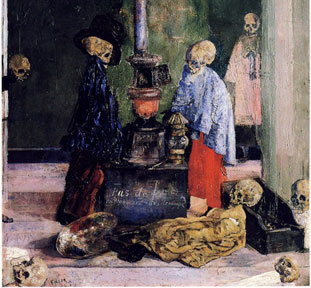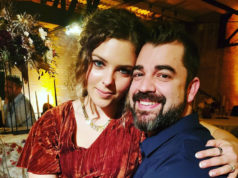
Philip Haas has based most of his films on odd works of fiction — the Oscar-nominated Angels and Insects came from A.S. Byatt’s novella Morpho Eugenia, and The Blood Oranges originated with an obscure John Hawkes book. Up at the Villa is from an M. Somerset Maugham story. Today, Haas is basing some of his new work on a different though no less cerebral artform: visual art.
Haas was recently commissioned by the Kimbell Art Museum to create short films inspired by works in the collection. The filmmaker has chosen Annibale Carracci’s “The Butcher’s Shop” (early 1580s); “Red-Figure Cup Showing The Death of Pentheus and a Maenad” by the ancient Greek Douris (circa 480 B.C.); “Arhat Taming the Dragon,” a Chinese scroll painting from the early 14th century; “Apollo and the Continents” by Giovanni Battista Tiepolo (circa 1739); and “Skeletons Warming Themselves” (1889) by James Ensor. Butchers, Dragons, Gods & Skeletons will open in July and run through October. Each film will be exhibited near its source material and, according to the museum, “will complement a full display of the Kimbell’s permanent collection.”
Haas’ pieces will include original music, and at some moments, the actors will congeal into the precise mise-en-scène depicted in the specific work of art.
The first piece in the series, Haas’ take on “The Butcher’s Shop,” was completed last year and screened in the 2008 Venice and Toronto film festivals.
With its mix of fantasy, allegory, and realism, Butchers, Dragons, Gods & Skeletons stands to fall somewhere amid several of its predecessors: early cinematic depictions of “The Young Painter” and “Mona Lisa”; the 2003 Scarlett Johansson vehicle, The Girl with a Pearl Earring; and Matthew Barney’s Cremaster Cycle. None of the bloodshed, muscles, or supernatural creatures, as far as we’ve learned, will be rendered via computer — for “Arhat,” for example, Haas has employed Blind Summit Theatre, a London outfit that makes plays with puppets for adults. (The puppet here will be the titular dragon.)
The chosen pieces lend themselves well to narrative treatments. “Skeletons” is a shadow-filled painting of several clothed skeletons gathered around a furnace in an empty room; in “Pentheus,” the king is torn apart by women who’d been whipped into a frenzy by Dionysus, whom Pentheus had disrespected; “Arhat” features a tangle between man and beast; and in “Apollo,” the god of medicine and the arts is accompanied by personifications of the planets and four continents. – Anthony Mariani
Semi Tough
Through nine grueling days, the 13th Van Cliburn International Piano Competition provided Fort Worth with some fantastic musical performances. Now the field of 29 contestants (reduced from 30 because Chu Yue pulled out before the competition with a hand injury) has been winnowed down to six, who will be playing with the Fort Worth Symphony Orchestra this week to determine the medal winners. Four of the finalists are Asian, reflecting that continent’s rising prominence in the classical world.
The main difference between this Cliburn and previous ones has little to do with the music, however. Improvements in media technology have made the contest accessible to the world outside the concert hall like never before. Bass Hall is outfitted with more cameras than ever, and the hall itself is now brightly lit during the performances to accommodate video documentation, whereas in the past audiences sat in near-total darkness. Complete audio and video footage of the performances has been streamlined and archived on the Cliburn’s webcasting site, though some computer users have complained about the video player’s incompatibility with Macs and older PCs. As of this writing the preliminary-round performances have all been uploaded to YouTube as well.
Press coverage has been similarly affected. While the print coverage in the Fort Worth Star-Telegram and the Dallas Morning News has been scaled down somewhat from recent years, the papers are still running in-depth features on individual pianists and trends such as the decline of the Russian musical education system. Much of the coverage has migrated to the internet, where bloggers can post during the breaks between performances and relay the immediacy and the musical impressions of the moment. In addition to Fort Worth Weekly‘s blog, online forums for Cliburn discussion have been provided by Scott Cantrell at Dallasnews.com, Matt Erickson at WRR Radio, and Olin Chism at KERA’s Art&Seek. The busiest blog, however, is the one on the Cliburn’s own site, written by multiple contributors. Opinions on the musicians have been flying fast and harsh enough to prompt the moderators to issue pleas for civility.
Of course, all this is secondary to the music, and several of the performers have been winning raves. Music critics covering the event were nearly unanimous in their acclaim for four of the finalists: Evgeni Bozhanov, the long-haired Bulgarian with gem-like sound and a sure command of large works; Son Yeol-eum, the Korean who plays with sweetness and electricity as needed; Wu Di, the brown-tressed Chinese colorist who can beguile audiences with warhorses and esoteric pieces alike; and Zhang Haochen, the slender teen prodigy with astonishing technique and a musical mind beyond his years. The other two finalists were Mariangela Vacatello, the petite Italian with a tasteful and acute approach to the music at hand, and Nobuyuki Tsujii, the raw but talented blind Japanese who emerged as a crowd favorite and human-interest story.
Other pianists who didn’t make the finals nevertheless attracted fervent fans, such as the American Spencer Myer and the Czech Lukáš Vondráček, brilliant colorists who went out in the prelims, and the Australian Andrea Lam, who made the semifinals but didn’t advance despite some sparkling accounts of Schumann, Brahms, and American music. Arguably no musician polarized listeners more than the Italian Alessandro Deljavan, whose interpretations of Schubert and Scriabin in the semifinals were praised for their color and fire but also chastised for their liberties with phrasing and rhythm. As American Idol and Britain’s Got Talent both proved recently, it isn’t just the winners of these contests that we come to hear. – Kristian Lin
Firefighter Memorial Dedication
On Friday at 9:30 a.m. at the north end of Trinity Park along West 7th Street, there will be a dedication ceremony for the Fort Worth Police and Firefighters Memorial. The huge bronze sculpture, which depicts a firefighter, police officer, and riderless horse, was designed by the Fort Worth architecture firm Gideon Toal and will be adjacent to two large sections of wall that will randomly list the names of all of the firefighters, police officers, and marshals who have died in the line of duty in Fort Worth. The memorial also includes black granite kiosks that will allow visitors to follow several eras of Fort Worth history and, according to www.cfwfallenheroes.org, “tell the stories of some of our fallen heroes.” The dedication will include a performance by Schola Cantorum of Texas, bagpipes, and the presentation of colors. The names and dates of death of all 95 of Fort Worth’s fallen heroes will be read aloud. – A.M.
Contact Kultur at kultur@fwweekly.com.











